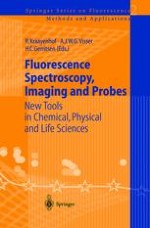2002 | OriginalPaper | Chapter
Fluorescence Spectral Engineering — Biophysical and Biomedical Applications
Authors : J. R. Lakowicz, I. Gryczynski, Y. Shen, J. Malicka, S. D’Auria, Z. Gryczynski
Published in: Fluorescence Spectroscopy, Imaging and Probes
Publisher: Springer Berlin Heidelberg
Included in: Professional Book Archive
Activate our intelligent search to find suitable subject content or patents.
Select sections of text to find matching patents with Artificial Intelligence. powered by
Select sections of text to find additional relevant content using AI-assisted search. powered by
Fluorescence spectroscopy is a central research tool in biology and has also become the dominant method enabling the revolution in biotechnology. At present, almost all fluorescence experiments are performed in a free space at condition, in which the oscillating dipole can radiate isotropically into space. We now describe a new opportunity, fluorescence spectral engineering (FSE), in which metallic surfaces or particles are used to modify the emission rates and spatial distribution of the emission. In this article we first summarize results from the physics literature which demonstrate the effects of metallic surfaces, colloids or islands to increase or decrease emissive rates, increase the quantum yields of low quantum yield chromophores, decrease the lifetimes, increase the distances for resonance energy transfer, and to direct the typically isotropic emission in specific directions. This latter effect is not the result of reflection, but rather as the result of the metal modifying the photon mode density surrounding the fluorophores and the fluorophore dipole interacting with free electrons in the metal. We then show experimental results, which demonstrate increased quantum yields, decreased lifetimes, increased photostability, and increased energy transfer distances near metal particles. Fluorescence spectral engineering provides opportunities for new types of fluorescence experiments and assays.
